BACK TO WEATHER-BLOG MENU
New! Fine Art Prints & digital images for sale-
Welsh Weather & Dyfi Valley landscapes Slide-Library - Click HERE
It's March 23rd and it is fair to say that very little of note has occurred on the weather-front since the last post. That's here in Wales, of course: what is going on Stateside is extraordinary. Here's Dr Jeff Masters from Weather Underground:
Pellston, MI: record high broken by 32°F
Pellston, Michigan in the Northern Lower Peninsula is called “Michigan’s Icebox”, since it frequently records the coldest temperatures in the state, and in the entire nation. But the past five days, Pellston has set five consecutive records for hottest March day. Yesterday’s 85° reading broke the previous record for the date (53° in 2007) by a ridiculous 32°, and was an absurd 48°F above average.
Low temperatures beat the previous record high for the date at two stations
The low temperature at Marquette, Michigan was 52° yesterday, which was 3° warmer than the previous record high for the date! The low at Mt. Washington, NH yesterday (44°) also beat the previous record high for the date (43°.)
Multiple Canadian cites break all-time April records for warmth in March
Not only was yesterday the warmest March day in recorded history for many of Canada’s major cities, it was also warmer than any April day at many locations. St. John, New Brunswick hit 25.4°C (78°F.) Not only did this crush the record high for March (previous record: 17.5°C), it is well above any temperature ever measured in April (extreme April temperature on record: 22.8°C.) Halifax, Nova Scotia hit 25.8°C yesterday, beating their all-time March record of 25.6°, and their all-time April record of 26.3°C, set on April 30, 2004. Other major cities in Canada that set all-time warmest March records yesterday included Ottawa (27.4°C), Montreal (25.8°C), Windsor (27.8°C), Hamilton (25.6°C), London (26.4°C), and Fredericton (27.1°C)….
You get the drift.....
What has made the news over here has been an extraordinary archaeological find down at Borth, more about which below. The main feature of the past few weeks' weather here in Wales has been cloudiness, which has been frustrating as I need to complete a photographic assignment. One afternoon I did manage to get some of it done when the cloud unexpectedly defied the forecast models and evaporated, leaving a sunny if hazy sky. It would have to do. Here are four shots from the shoot: the first is looking north along Morfa Harlech from the high ground near Llandanwg:

This is the beautiful Glaslyn Estuary at Borth-y-Gest near Porthmadog:
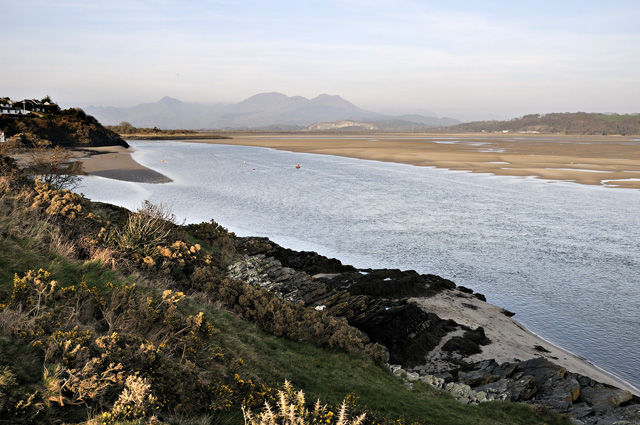
This is an early-evening telephoto shot from Black Rock Sands, looking west towards Criccieth Castle:
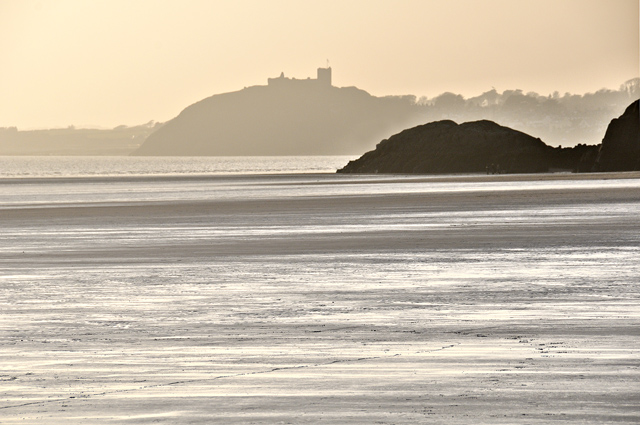
And finally, a watery sunset looking along the beach at Pwllheli from Gimlet Rock.
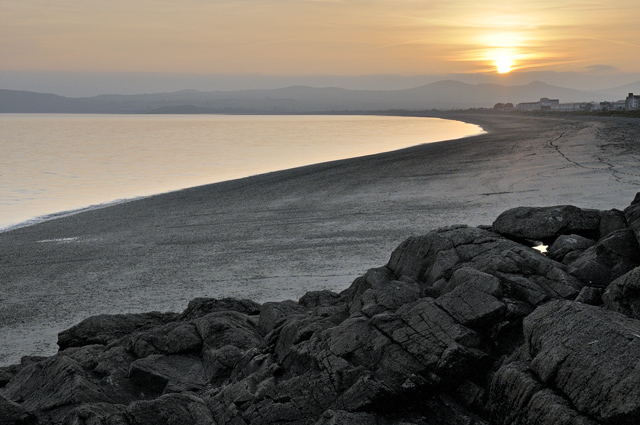
The first decent convection occurred on March 17th, and I captured it under development at Ynyslas in the morning:
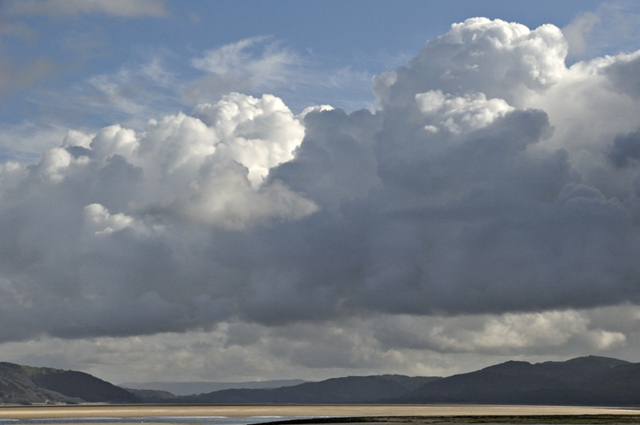
Nothing severe was forecast, but the same line looking south-west was set-off nicely by upper-level cirrus:
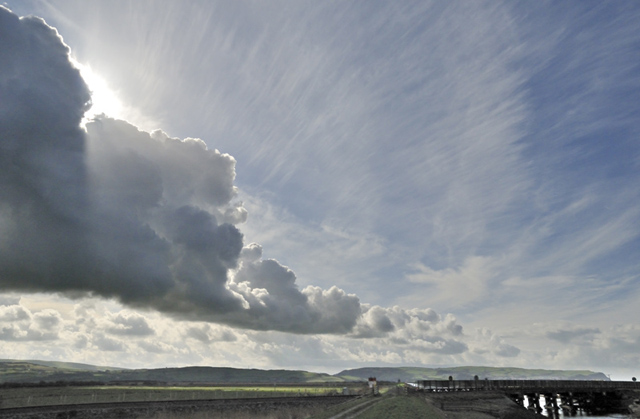
At the time, I was heading to a rendezvous at the southern end of Borth Beach, so I had to move on and leave the convection to its own devices.
The Submerged Forest at Borth is a well-known sight to locals and visitors alike. It tends to get uncovered in the stormier months of the year and it most frequently appears down towards Ynyslas, where there are the stumps of many pines in growth position, as in this image taken in November 2009:
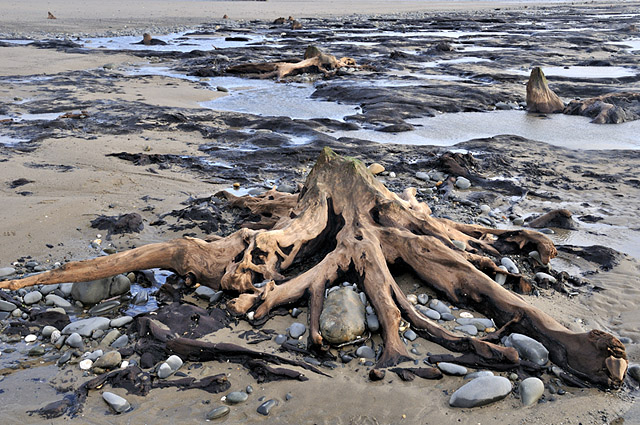
This year, something unusual has occurred: the sands have been scoured at the far southern end of the beach, below the Lifeboat Station. In this photo, areas of peat can be seen beyond the stonework. In the distance R are the artificial reef works beyond the low tide mark.
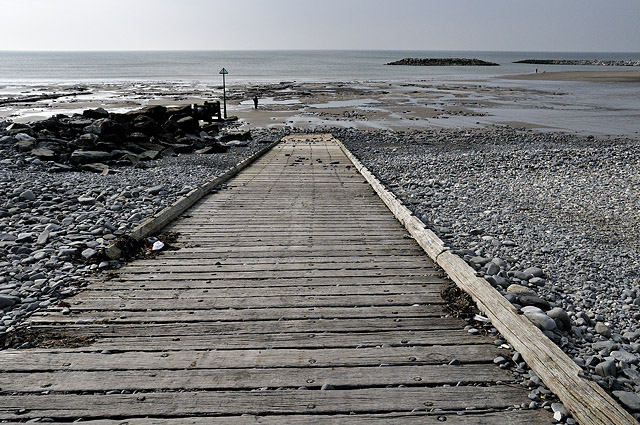
Here's a view along the beach looking north, with peat-beds emerging from the sand:
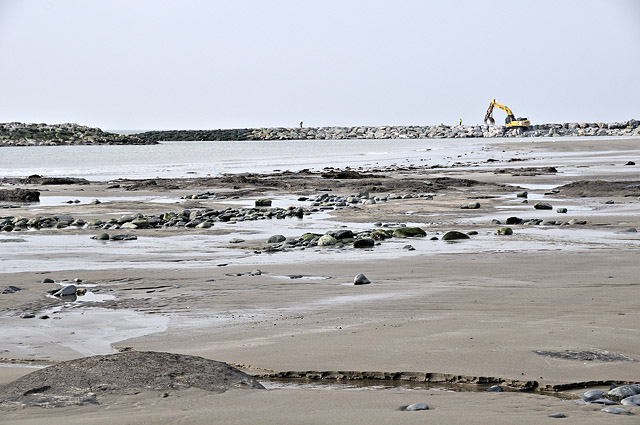
Here is the sequence of beds in a sampling-trench cut by a team of archaeologists supervised by Dr Martin Bates of Lampeter University. A dark lower peat, in which occur the tree-stumps, is overlain by a clay that was deposited in salt-marsh conditions. Atop that is a thin upper peat.

The lower peat contains drifts of woody debris in places:

The clay contains finer plant-debris - various rushes and other marsh-dwellers:

Dr Bates' interest in the site stemmed from his retired geology lecturer father's discovery of scatters of burnt stone back in February 2012. Here is one such scatter. Burnt stone is a feature typical of many Bronze Age occupation sites. The folk back then would heat up rocks and plunge them into cold water - perhaps to heat it or, as some archaeologists have speculated, perhaps it had something to do with sweat-lodges akin to the Native American tradition. Either way, the sudden immersion into cold water would cause the rocks to shatter into numerous angular fragments....
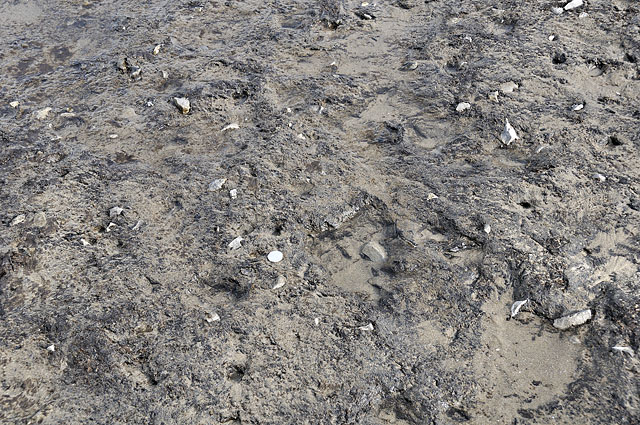
Here's a close-up of part of the same scatter:

But the archaeological team found much more. If the appearance of the peat here reminds you of a boggy field in which cattle have been trampling around, you would not be at all wide of the mark:
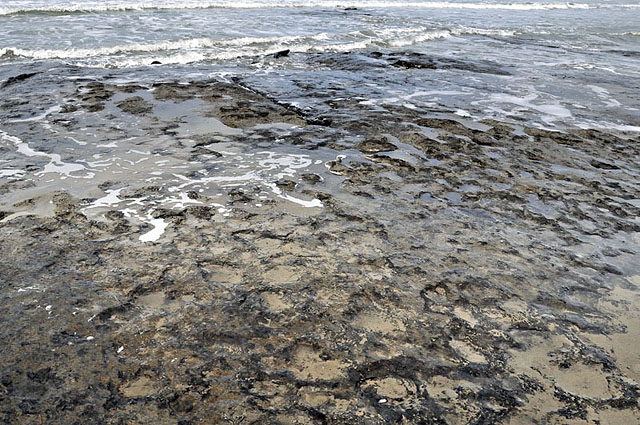
The same area on another day - the sand moves about so that different areas cover and uncover on different tides. Note that the peat is now quite hard so that stamping on it in heavy Rigger-boots barely makes a mark:
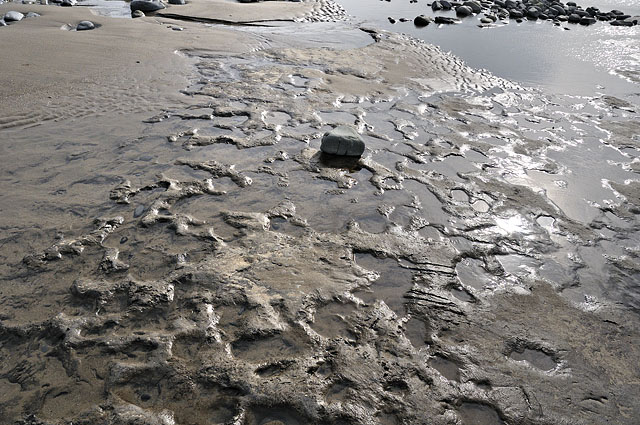
As well as hoof-marks from cattle and sheep or goats, human prints were also found. This is a likely one:
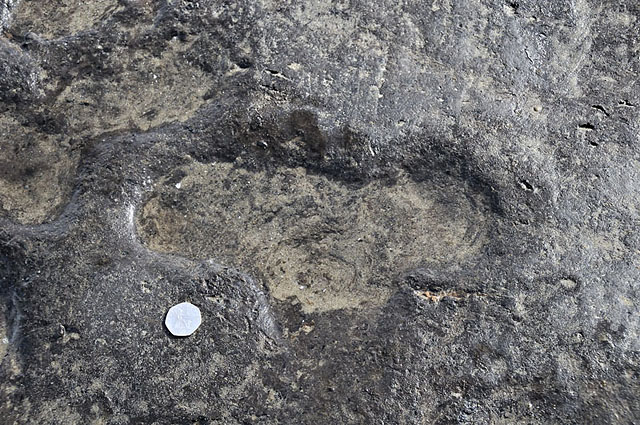
This is a good one we discovered on the 17th. When these were made the surface must have been soft-going to treacherous, so that anyone walking across would perhaps squelch along but go in up to their knees in places. Remember that other deposits that overlay the upper peat have since been eroded.
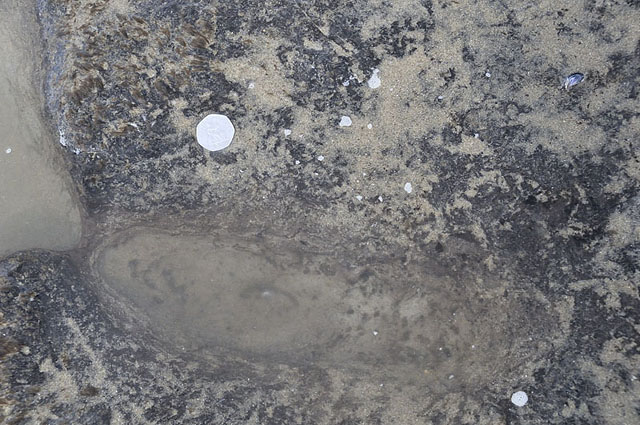
There are few trees in this part of the Submerged Forest. Here's a fallen oak. The end has been cut off for tree-ring studies and carbon-dating.
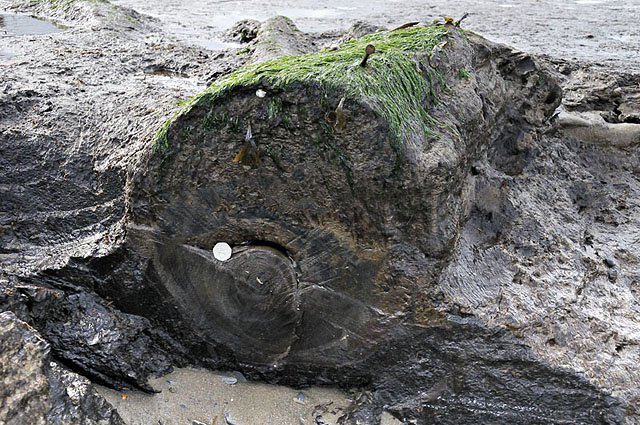
What's the timeline here?
The basal peat dates back to 6,500 years before present and the trees came and went over some 3,000 years, before sea-level rise led to incursions of salt-water from the north, waterlogging and killing them. The footprints and the burnt stone are both from the Bronze Age, 4,150-2,750 years ago: given the dates obtained so far their likely age is ca, 3,000 years or so. At some point later on, the open coast, originally about a kilometre seaward, moved landwards so that eventually the storm-beach and hinterland dunes pushed over the remains of the forest, by then well below the high water mark. This was the final flourish of the 120 metre sea-level rise that accompanied the deglaciation following the last glacial maximum, 20,000 years ago. The inundation of much of Cardigan Bay happened over the past 9,000 years, during which the final 20 of the 120 metres rise occurred, so that the process took place during the Mesolithic, the Neolithic and Bronze Ages, when the area was populated. Does make one wonder about the Cantre'r Gwaelod Legend afresh!

Work continues to buy Borth a bit of time in the face of renewed sea-level rise: once the artificial reef complex is completed the temporary causeway to it will be removed and then we shall have to see how Borth fares when the next major storm strikes. There hasn't been anything too bad of late, so it'll likely be next winter at the earliest when we see the structures put to the test.
My thanks are due to Martin Bates for showing me around the site. More soon!
BACK TO WEATHER-BLOG MENU
New! Fine Art Prints & digital images for sale-
Welsh Weather & Dyfi Valley landscapes Slide-Library - Click HERE